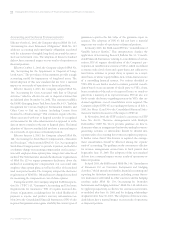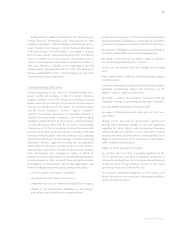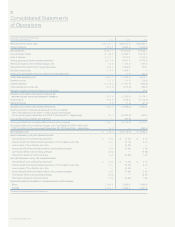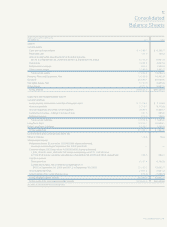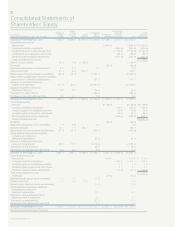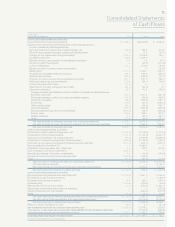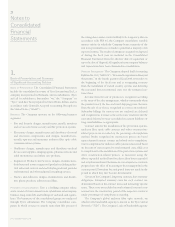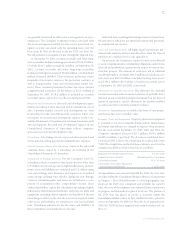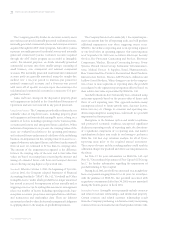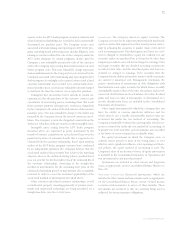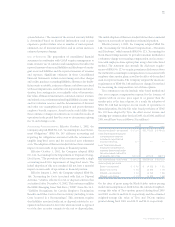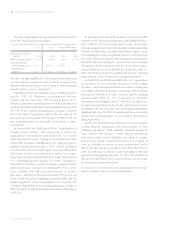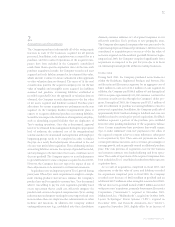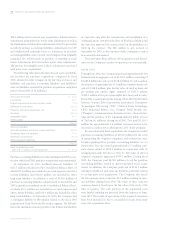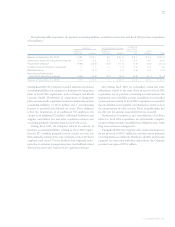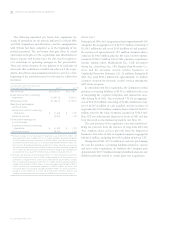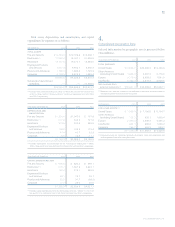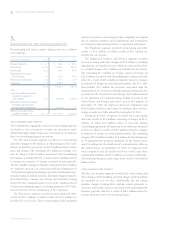ADT 2003 Annual Report Download - page 76
Download and view the complete annual report
Please find page 76 of the 2003 ADT annual report below. You can navigate through the pages in the report by either clicking on the pages listed below, or by using the keyword search tool below to find specific information within the annual report.
74
Share Premium and Contributed Surplus In accordance with the
Bermuda Companies Act of 1981, when Tyco issues shares for
cash at a premium to their par value, the resulting premium is
credited to a share premium account, a non-distributable reserve.
When Tyco issues shares in exchange for shares of another
company, the excess of the fair value of the shares acquired over
the par value of the shares issued by Tyco is credited, where
applicable, to contributed surplus, which is, subject to certain
conditions, a distributable reserve.
Income Taxes Deferred tax liabilities and assets are recognized
for the expected future tax consequences of events that have
been reflected in the Consolidated Financial Statements.
Deferred tax liabilities and assets are determined based on the
differences between the book values and the tax basis of partic-
ular assets and liabilities, using tax rates in effect for the years
in which the differences are expected to reverse. A valuation
allowance is provided to offset any net deferred tax assets if,
based upon the available evidence, it is more likely than not
that some or all of the deferred tax assets will not be realized.
Financial Instruments All derivative instruments are reported
on the balance sheet at fair value. Changes in a derivative’s fair
value are recognized currently in earnings unless specific hedge
criteria are met. At its inception, if the derivative is designated
as a fair value hedge, the changes in the fair value of the deriv-
ative and of the hedged item attributable to the hedged risk are
recognized as a charge or credit to earnings.
The fair value estimates are based on relevant market infor-
mation, including current market rates and prices, assuming
adequate market liquidity. Fair value estimates for interest rate
and cross-currency swaps are provided to the Company by
high-quality third-party financial institutions known to be
high volume participants in this market.
The Company uses derivative instruments to manage expo-
sures to foreign currency, commodity price and interest rate
risks. The Company’s objectives for utilizing derivatives is to
manage these risks using the most effective methods to elimi-
nate or reduce the impacts of these exposures. The Company
documents relationships between hedging instruments and
hedged items, and links derivatives designated as fair value,
cash flow or foreign currency hedges to specific assets and lia-
bilities on the Consolidated Balance Sheet or to specific firm
commitments or forecasted transactions. The Company also
assesses and documents, both at the hedge’s inception and on
an ongoing basis, whether the derivatives that are used in hedg-
ing transactions are highly effective in offsetting changes in fair
values or cash flows associated with the hedged items.
As part of managing the exposure to changes in market
interest rates, the Company, as an end-user, enters into various
interest rate swap transactions, all of which are transacted in
over-the-counter markets, with other financial institutions acting
as principal counterparties. To ensure both appropriate use as a
hedge and hedge accounting treatment, all derivatives entered
into are designated according to a hedge objective against specified
liabilities such as a specifically underwritten debt issue. The
Company’s primary hedge objectives include the conversion of
fixed-rate liabilities to variable rates. The derivatives associated
with these objectives are classified as fair value hedges.
As part of managing the exposure to changes in foreign
currencies, the Company utilizes forward and option contracts
transacted in over-the-counter markets, with financial institu-
tions acting as principal counterparties. The objective of these
hedging contracts is to minimize impacts to cash flows due to
changes in foreign exchange rates on intercompany loans,
booked accounts and notes receivable and accounts payable,
and forecasted transactions. Only in very limited circumstances
is hedge accounting designated. The remaining hedges are
marked to market.
The Company’s derivative instruments present certain
market and counterparty risks; however, concentration of
counterparty risk is mitigated as Tyco deals with a variety of
major banks worldwide with long-term Standard & Poor’s and
Moody’s credit ratings of A+/A1 or higher. In addition, only
conventional derivatives are utilized thereby affording optimum
clarity as to the market risk. None of the Company’s derivative
instruments outstanding at year end would result in a significant
loss to the Company if a counterparty failed to perform accord-
ing to the terms of its agreement. At this time, the Company
does not require collateral or other security to be furnished by
the counterparties to its derivative instruments.
Accrued Product Warranty The Company generally accrues
estimated product warranty costs at the time of sale, and any
additional amounts are recorded when such costs are probable
and can be reasonably estimated. Manufactured products are
warranted against defects in material and workmanship when
properly used for their intended purpose, installed correctly,
and appropriately maintained. Generally, product warranties
are implicit in the sale; however, the customer may purchase an
extended warranty. Manufactured equipment is also warranted
in the same manner as product warranties. However, in most
instances the warranty is either negotiated in the contract or sold
as a separate component. Warranty period terms range from
90 days (e.g., consumable products) up to 20 years (e.g., power
TYCO INTERNATIONAL LTD.
Notes to Consolidated Financial Statements


